By Gabriel Martínez del Mármol Marín, Marco Sassoe and Baudilio Rebollo Fernández.
[wpgmappity id=”5″]
Clic en los puntos del mapa para mostrar localidad.
On August 16th, 2013 the three of us met at the Menara airport in Marrakech to start a 2-weeks herping tour that brought us from the extreme heat of the barren Western Sahara desert to the verdant mountain prairies of the Middle and High Atlas. Budi and Marco had begun their journey independently a little earlier, and met Gabriel in the airport hall where everyone seems to be waiting to meet someone!. The presentation was short because it was getting dark and we had planned to go to the region of Agadir that night. On the way Budi told us his findings of the previous two days: several amphibians (Hyla meridionalis, Discoglossus scovazzi, Amietophrynus mauritanicus, Pelophylax saharicus) and reptiles (Natrix maura, Hemorrhois hippocrepis), and many cattle egrets (Bubulcus ibis).

Casablanca landscape. Photo: © Baudilio Rebollo Fernández.

Bubulcus ibis. Photo: © Baudilio Rebollo Fernández.

Discoglossus scovazzi. Photo: © Baudilio Rebollo Fernández.

Tarentola mauritanica. Photo: © Baudilio Rebollo Fernández.

Natrix maura. Photo: © Baudilio Rebollo Fernández.

Hemorrhois hippocrepis. Photo: © Baudilio Rebollo Fernández.

Hyla meridionalis. Photo: © Baudilio Rebollo Fernández.
In Agadir we found some of the most typical species of Morocco: the tortoise (Testudo graeca), the Agadir´s gecko (Saurodactylus brosseti), several Algerian orange-tailed skinks (Eumeces algeriensis), common geckos (Tarentola mauritanica), the viperine snake (Natrix maura), the Montpellier snake (Malpolon monspessulanus) and the Moorish viper (Daboia mauritanica).

Malpolon monspessulanus. Photo: © Baudilio Rebollo Fernández.

Malpolon monspessulanus. Photo: © Gabri Mtnez.

Daboia mauritanica. Photo: © Gabri Mtnez.

Daboia mauritanica. Photo: © Baudilio Rebollo Fernández.

Daboia mauritanica. Photo: © Marco Sassoe.

Agadir landscape. Photo: © Marco Sassoe.

Eumeces algeriensis. Photo: © Marco Sassoe.
After a sleepless night that we spent photographing these species, we headed South to Guelmim. On the way we made a brief stop in Tiznit, where we could rescue a horseshoe whip snake (Hemorrhois hippocrepis) and a Schokar sand-snake (Psammophis schokari) from water cisterns. Local people clustered around us showing great admiration for the way we handled snakes. These people were very curious about what we were doing; they did not distinguish between poisonous and non-poisonous snakes and appeared to be horrified by any serpent. We had to insist quite a lot before convincing them to touch a harmless horseshoe whipsnake.

Testudo graeca. Photo: © Baudilio Rebollo Fernández.

Tiznit landscape. Photo: © Marco Sassoe.

Marco and Budi showing to local people that not all the snakes are dangerous.
The snake was rescued in a water tank. After some photos was released some meters away of the water tank. Photo: © Gabri Mtnez.

Hemorrhois hippocrepis. Guelmim. Photo: © Baudilio Rebollo Fernández.

Psammophis schokari. Guelmim. Photo: © Baudilio Rebollo Fernández.
In Guelmim we rented a room in a hotel to rest a bit and in the evening we took a walk in a large wadi. The temperature was optimal, there was no wind and it seemed a perfect night for herps, but we soon found out that reptile activity was very limited: we were able to see only two of the most typical species of the Atlantic coast of Southern Morocco: a Bibron´s agama (Agama impalearis) and a Moorish skink (Chalcides polylepis). We therefore decided to go to Sidi Ifni, where we found a large (170 cm) DOR horseshoe whip snake (Hemorrhois hippocrepis) and the real surprise of the trip: a Sahel egg-eater snake (Dasypeltis sahelensis), that had been recently killed by a car. This snake is specialized in feeding on bird eggs and its annual activity is believed to be largely restricted to the bird breeding season. It is usually encountered in spring (March-June) and autumn, and we did not expect to observe this species in the driest and hottest part of the year. Morocco is always a surprise, and every time we go we realize that there is so much we have to learn about its animals!

Agama impalearis. Guelmim. Photo: © Baudilio Rebollo Fernández.

Chalcides polylepis. Guelmim. Photo: © Gabri Mtnez.
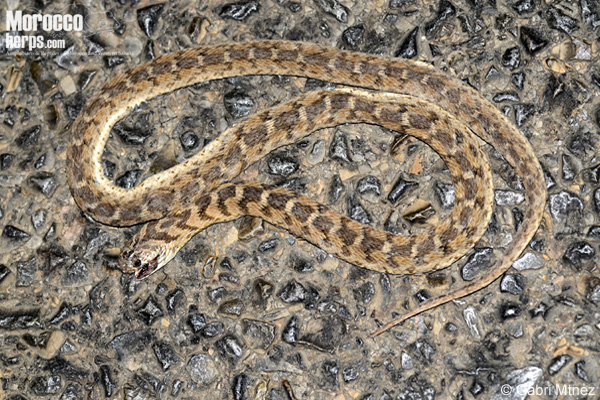
Dasypeltis sahelensis. Sidi Ifni. Photo: © Gabri Mtnez.
In the following day we left Guelmim and headed to the Tantan region. On the way we rescued two horseshoe whip snakes (Hemorrhois hippocrepis), an orange-tailed skink (Eumeces algeriensis) and some north African green toads (Bufotes boulengeri) from water cisterns. The temperature was high and there was no activity, not even of agamids, which greatly decrease their daily period of activity in August.
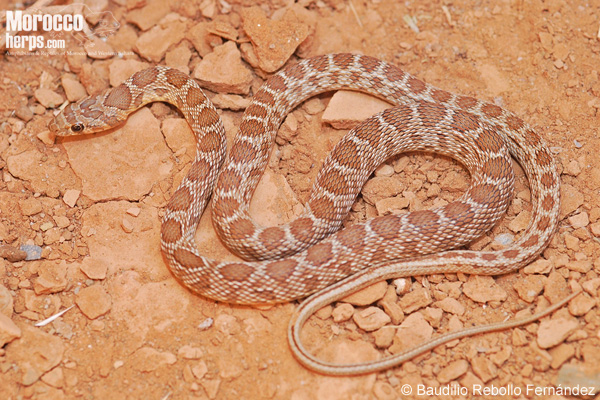
Hemorrhois hippocrepis. Guelmim. Photo: © Baudilio Rebollo Fernández.

Acanthodactylus busacki. Guelmim. Photo: © Baudilio Rebollo Fernández.

Guelmim landscape. Photo: © Gabri Mtnez.

Tantan landscape. Photo: © Gabri Mtnez.
In Tantan we found an Acanthodactylus boskianus and we received the first cold shower of the trip: an adult Egyptian cobra (Naja haje) that we found dead. We next went to search for snake tracks in nearby dunes but there were absolutely none (although we saw many tracks from invertebrates and small reptiles such as geckos or skinks). At night we found some invertebrates and the typical species of geckos (Tarentola chazaliae, Stenodactylus mauritanicus), but not finding any snake tracks we decided to set our camp for the night.

Detail of the proteroglyphous dentition in a dead adult Naja haje. Photo: © Gabri Mtnez.

Acanthodactylus boskianus. Tantan. Photo: © Baudilio Rebollo Fernández.

Stenodactylus mauritanicus, juvenile. Photo: © Gabri Mtnez.

Tarentola chazaliae individuals. Photo: © Marco Sassoe.
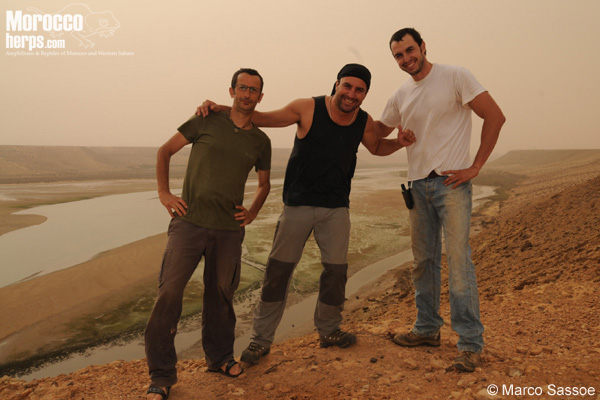
Marco, Budi and Gabri in the Oued Draa. Photo: © Marco Sassoe.
Later we drove South to Western Sahara where our luck changed and we found several species of desert reptiles: house geckos (Tarentola annularis), two sand vipers (Cerastes vipera) and a large horned viper (Cerastes cerastes), that despite its exorbitant size exhibited the amazing design of sand and gray tones that usually characterizes juveniles.

Camels crossing the road in Western Sahara. Photo: © Marco Sassoe.

Tarentola annularis. Smara. Photo: © Marco Sassoe.

Tarentola annularis. Smara. Photo: © Baudilio Rebollo Fernández.

Smara landscape. Photo: © Gabri Mtnez.

Cerastes vipera. Smara. Photo: © Baudilio Rebollo Fernández.
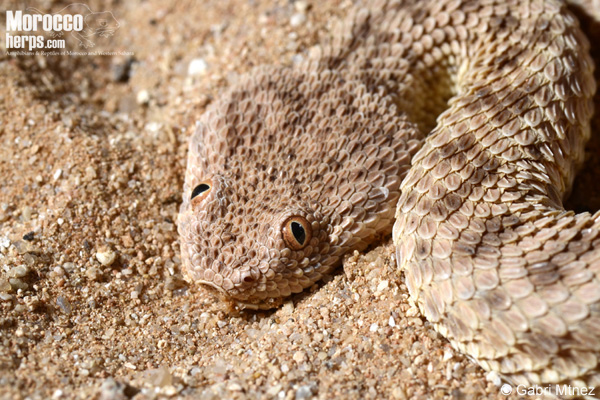
Cerastes vipera, detail of a second individual. Photo: © Gabri Mtnez.

Cerastes vipera. Photo: © Marco Sassoe.

Cerastes cerastes. Photo: © Marco Sassoe.

Cerastes cerastes. Photo: © Marco Sassoe.

Cerastes cerastes. Photo: © Marco Sassoe.

Scorpion. Photo: © Marco Sassoe.

Marco Sassoe in Smara. Photo: © Baudilio Rebollo Fernández.
After an exhaustive photographic session, we continued the trip and just before entering the city of Smara we were upset again by the find of a DOR specimen of desert monitor (Varanus griseus), probably hit some hours before. This species is one of the most persecuted reptiles of North Africa. The conviction that the simple smell of the Varanus keeps away snakes and scorpions and other similar misbeliefs have contributed to the depletion of wild populations. Local people still capture these large lizards to use their skin or skull as amulets. The Smara region is possibly one of the best places to see these animals, and as we left this town we thought we were losing our best chance to find a live monitor on this trip.

Varanus griseus DOR. Photo: © Baudilio Rebollo Fernández.
Until Laayoune, activity was low (but the temperature was very high!) and we only got to see some individuals of Bohme´s Agama (Trapelus boehmei). It was getting dark when we reached Laayoune, and we soon found a snake with an odd pattern belonging to the genus Hemorrhois.
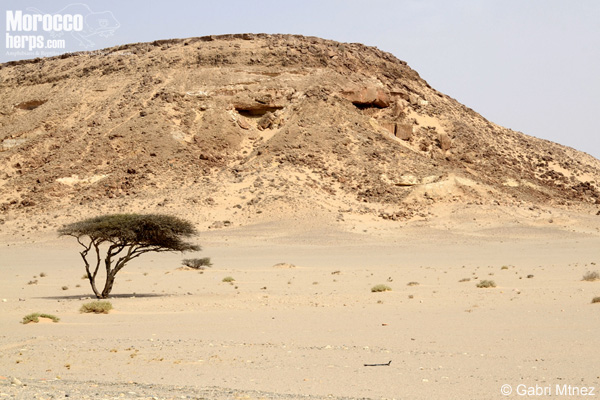
Smara landscape. Photo: © Gabri Mtnez.

Trapelus boehmei. Photo: © Gabri Mtnez.

Laayune landscape. Photo: © Baudilio Rebollo Fernández.

Hemorrhois algirus intermedius. Photo: © Gabri Mtnez.

Hemorrhois algirus intermedius, detail. Photo: © Marco Sassoe.
On the way to Tarfaya, we stopped to explore sandy areas and we could see some interesting species: several common geckos (Tarentola mauritanica), 7 hooded snakes (Macroprotodon sp.) and despite the multitude of traces of sand viper (Cerastes vipera) we only found one individual. This viper had a very different colour compared to the two specimens observed in Smara: an unforgettable experience to see such a variety of colours and designs in this species in such a short time.

Budi and Marco looking for tracks in the sand during the first hours of the night. Photo: © Gabri Mtnez.

Macroprotodon sp.. Photo: © Marco Sassoe.

Macroprotodon sp.. Photo: © Gabri Mtnez.
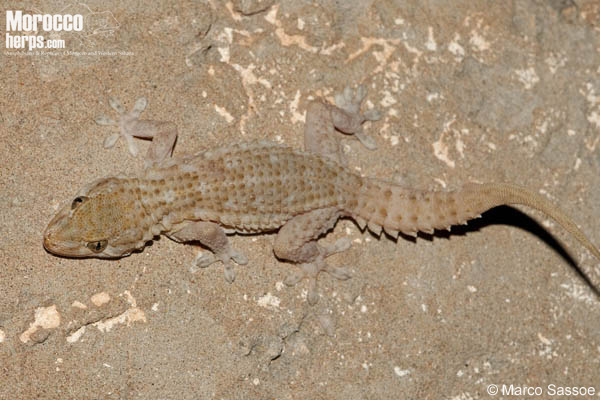
Tarentola mauritanica. Photo: © Marco Sassoe.
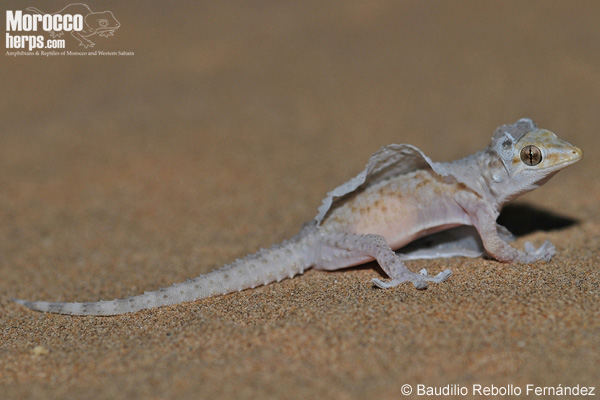
Tarentola mauritanica. Photo: © Baudilio Rebollo Fernández.

Cerastes vipera tracks. Photo: © Gabri Mtnez.

Cerastes vipera. Photo: © Baudilio Rebollo Fernández.

Cerastes vipera. Photo: © Marco Sassoe.

Cerastes vipera. Photo: © Marco Sassoe.
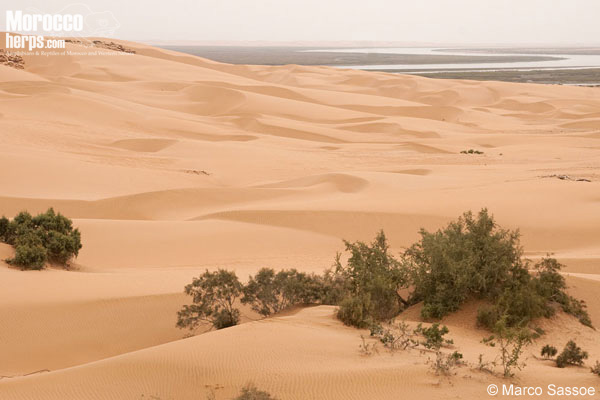
Tarfaya landscape. Photo: © Marco Sassoe.
We rested a few hours inside our tents to recover from fatigue and mosquitoes and started our journey back to the city of Tantan. On the way we saw another hooded snake (Macroprotodon sp.), some toads (Bufotes boulengeri, Barbarophryne brogersmai), and a helmet gecko (Tarentola chazaliae). We then faced what was possibly the worst moment of our trip: we found another dead Egyptian cobra (Naja haje), an adult specimen. The cobra had obviously been killed shortly before our arrival, and showed lesions possibly caused by rocks. The crudest conflict between people and snakes was in front of our eyes! We tried to encourage us thinking that many cobras living in more remote areas have deposited their eggs to ensure the survival of this species so heavily persecuted by man.
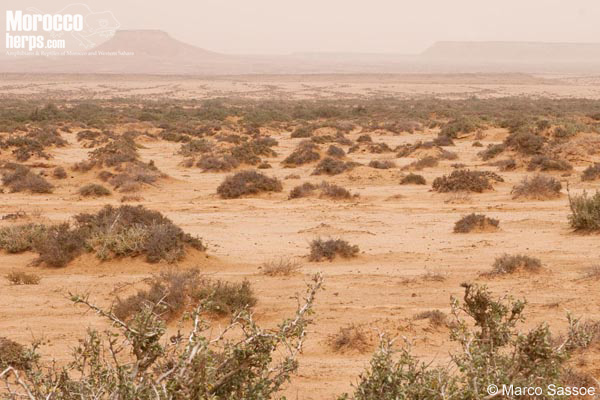
Tantan landscape. Photo: © Marco Sassoe.

Bufotes boulengeri. Photo: © Baudilio Rebollo Fernández.

Barbarophryne brogersmai. Photo: © Marco Sassoe.

Tantan people. Photo: © Marco Sassoe.

Tantan landscape. Photo: © Marco Sassoe.

Tarentola chazaliae. Photo: © Baudilio Rebollo Fernández.
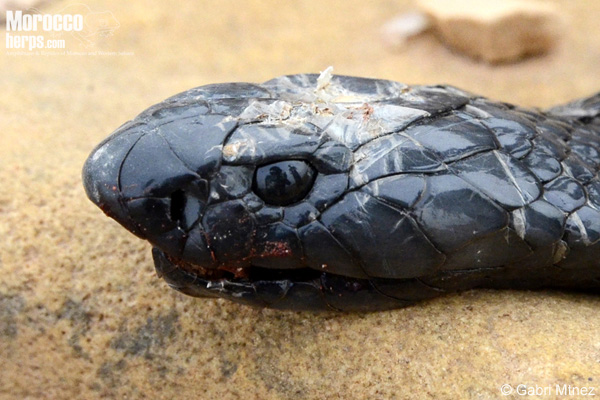
Naja haje, detail of an adult individual killed. Photo: © Gabri Mtnez.
We then continued our drive towards Guelmim where we picked a good area to sleep on the stony desert floor. The next morning we had the chance to observe some of the inhabitants of the drylands between Guelmim and Tantan. These areas are “magical” as several factors make possible the coexistence in strict sympatry of animals of diverse origin. In just a small area we found animals typical of arid environments, such as Spiny-tailed lizards (Uromastyx nigriventris), elegant geckos (Stenodactylus mauritanicus), diadem snakes (Spalerosophis dolichospilus) and false cobras (Rhagerhis moilensis), as well as herps typical of the Mediterranean, such as Moroccan orange-tailed skinks (Eumeces algeriensis) and horseshoe whip snakes (Hemorrhois hippocrepis). Horseshoe Whip Snakes are especially variable in pholidosis, designs and colour in these areas, and we saw examples of “typical” colour with more reddish and darker specimens. Our search was halted by a strong sandstorm that forced us to get into the car to avoid destroying our photographic equipment.

Guelmim landscape. Photo: © Gabri Mtnez.

Rhagerhis moilensis. Photo: © Marco Sassoe.

Rhagerhis moilensis. Photo: © Baudilio Rebollo Fernández.

Chalcides polylepis. Photo: © Marco Sassoe.

Stenodactylus mauritanicus. Photo: © Marco Sassoe.

Spalerosophis dolichospilus, reddish individual. Photo: © Gabri Mtnez.

Hemorrhois hippocrepis. Photo: © Marco Sassoe.

Hemorrhois hippocrepis. Photo: © Gabri Mtnez.
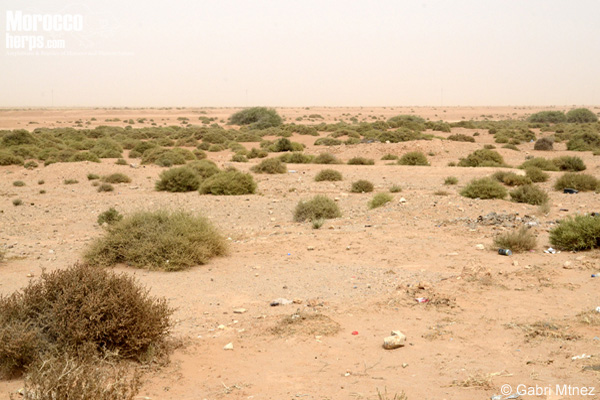
Guelmim landscape. Photo: © Gabri Mtnez.
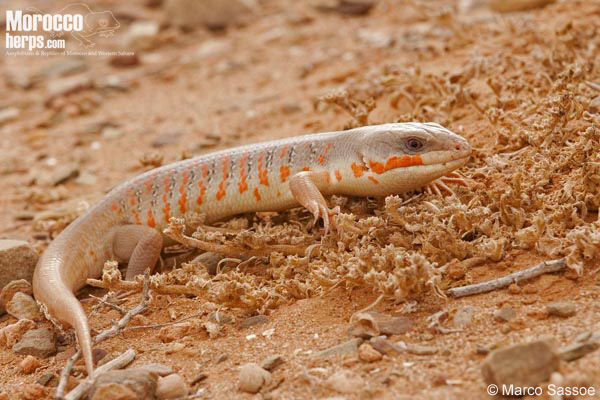
Eumeces algeriensis. Photo: © Marco Sassoe.

Hemorrhois hippocrepis. Photo: © Gabri Mtnez.
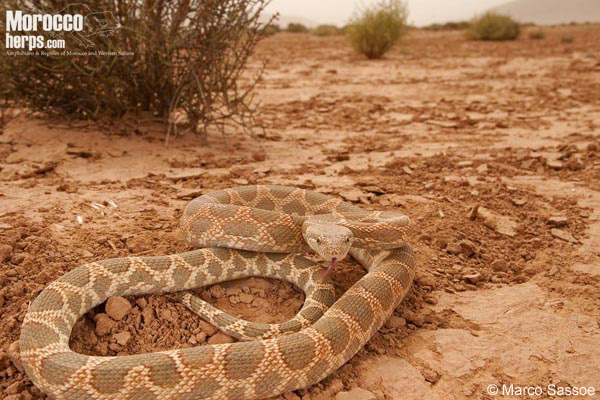
Spalerosophis dolichospilus, “pale” individual. Photo: © Marco Sassoe.

Hemorrhois hippocrepis. Photo: © Gabri Mtnez.

Hemorrhois hippocrepis. Photo: © Gabri Mtnez.

Sand storm in Guelmim. Photo: © Gabri Mtnez.
In the city of Guelmim we took a shower in a simple hotel, and when the sun went down we put all our efforts into driving the area where we had seen the Dasypeltis sahelensis just a few days before. Unfortunately road cruising was unsuccessful: no snakes, mammals or invertebrates, absolutely nothing. So we went to the coast to try our luck in the city of Sidi Ifni, where the temperature was lower. It did not take long before we found a sub-adult puff adder (Bitis arietans) in the middle of the road. It was intact and most likely it had been killed recently by a vehicle. We drove further and soon found a large adult of the same species, which also had been killed by a vehicle. We were surprised to see how activity can change from one area to another, although we were very sorry that the only two Bitis of the trip were DOR specimens. Before going to sleep we visited a small stream where we could photograph some frogs (Pelophylax saharicus) and toads (Amietoprhynus mauritanicus).
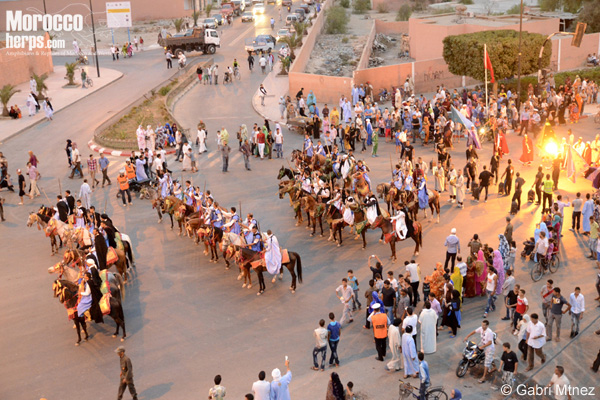
Guelmim spectacle. Photo: © Gabri Mtnez.

Budi checking a water tank. Photo: © Gabri Mtnez.

Two individuals of Hemorrhois hippocrepis inside a water tank. Photo: © Gabri Mtnez.

Subadult Bitis arietans, just DOR. Photo: © Baudilio Rebollo Fernández.
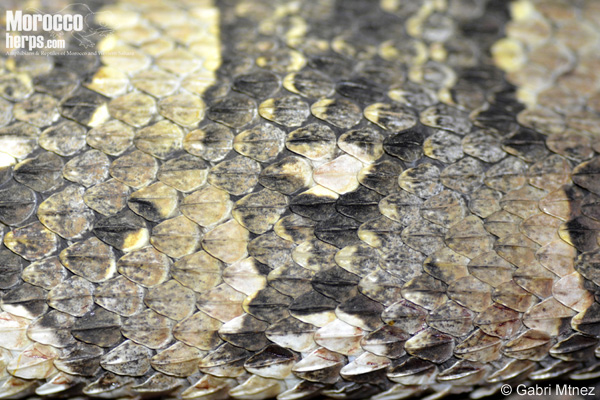
Bitis arietans detail. Photo: © Gabri Mtnez.

Adult Bitis arietans DOR. Photo: © Gabri Mtnez.
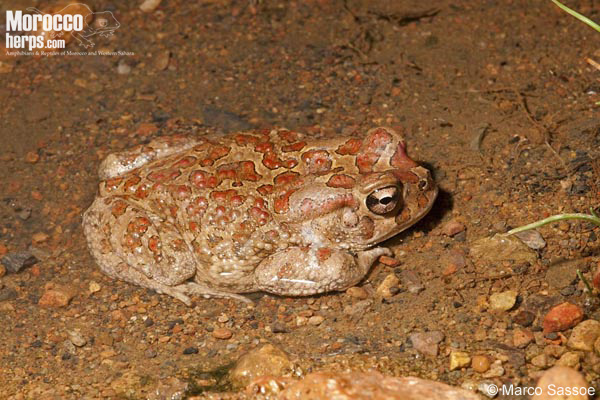
Amietophrynus mauritanicus. Photo: © Marco Sassoe.

Pelophylax saharicus. Photo: © Marco Sassoe.

Pelophylax saharicus. Photo: © Marco Sassoe.
The next day we drove from Guelmim to the area of Assa, enjoying the spectacular landscapes of the Anti-Atlas mountains. In Assa we found some Draa geckos (Tarentola boehmei), a male Bibron´s agama (Agama impalearis), and a Boehme agama (Trapelus boehmei). We then found a large and powerful desert monitor (Varanus griseus). As one of us approached the animal, he reacted defensively with tail lashes and eventually placed a hard bite into one glove when it was grabbed. The monitor held on for a few minutes, until his teeth passed through the glove. These gloves are used to handle poisonous snakes and we did not expect that a monitor lizard could bite through them! We had underestimated the strength of his jaws, that are designed to kill preys: vertebrates of small or medium size. After many photographs, the animal returned to the reg where it lived.

Fask-Assa landscape. Photo: © Marco Sassoe.

Road to Assa. Photo: © Marco Sassoe.

Agama impalearis. Photo: © Gabri Mtnez.

Tarentola boehmei. Photo: © Baudilio Rebollo Fernández.
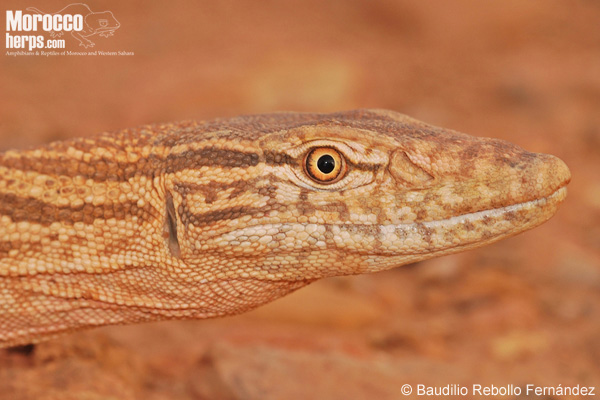
Varanus griseus, head close-up. Photo: © Baudilio Rebollo Fernández.

Varanus griseus, head close-up. Photo: © Marco Sassoe.

Varanus griseus. Photo: © Marco Sassoe.

“Special glove” to handle venomous reptiles. Snakes of the genus Cerastes, Atractaspis, Naja, Daboia, Bitis, Echis and Vipera have bitten this glove without consequences. But this big lizard broke it!!. Photo: © Gabri Mtnez.

“Special glove” detail. Photo: © Gabri Mtnez.
From Assa we drove to Tata, and although it was dark and we were hoping to see animals on the road, we did not find anything. August is bleak! In Tata we set our night camp and used our residual energies for a final lap, during which we found some geckos (Tarentola boehmei, Tropiocolotes algericus), an Ocellated Skink (Chalcides ocellatus) and a strange snake probably close to Hemorrhois hippocrepis.

Chalcides ocellatus. Photo: © Marco Sassoe.
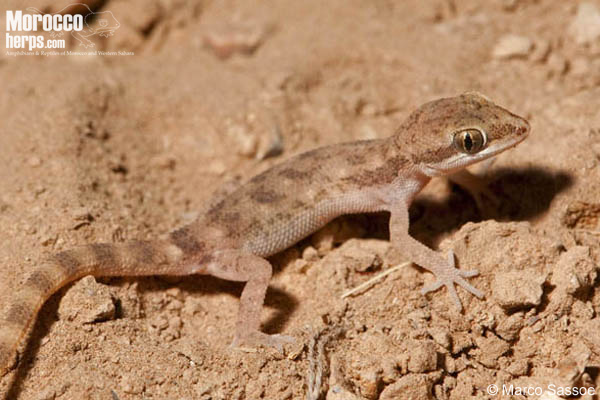
Tropiocolotes algericus. Photo: © Marco Sassoe.

Hemorrhois “algirus intermedius”. Photo: © Marco Sassoe.

Tata landscape. Photo: © Baudilio Rebollo Fernández.

Tata landscape. Photo: © Marco Sassoe.

Tata landscape. Photo: © Marco Sassoe.

Igherm landscape. Photo: © Gabri Mtnez.
The next day we drove to Taroudant. Along the way, apart from the spectacular scenery, we only found some Bibron´s Agamas (Agama impalearis) and a horseshoe whip snake (Hemorrhois hippocrepis). In the Souss Valley, we made some brief stops where we could see some amphibians (Pelophylax saharicus, Amietoprhynus boulengeri), Bibron´s Agamas (Agama impalearis), a tortoise (Testudo graeca), a Moroccan skink (Chalcides polylepis) and a horseshoe whip snake (Hemorrhois hippocrepis).

Hemorrhois hippocrepis. Photo: © Baudilio Rebollo Fernández.
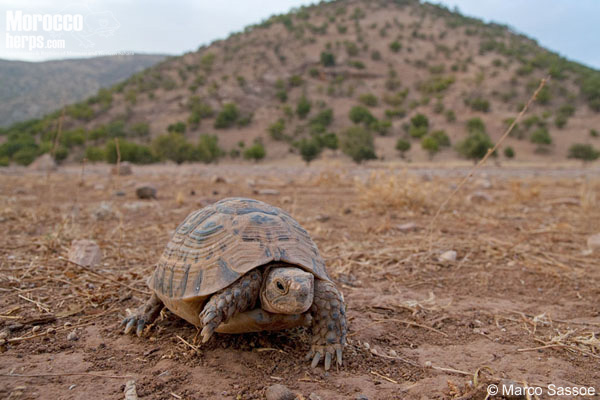
Testudo graeca. Photo: © Marco Sassoe.

Taroudant landscape. Photo: © Marco Sassoe.
It was getting dark and we made an effort to drive up the Agdz area. Night fell on the way, but again we did not observe any kind of animal on the road. We arrived late but the temperature was good, so we had some food, set up the tents for the night and went to explore an interesting palm plantation (palmeraie). We found some geckos (Saurodactylus brosseti, Tarentola boehmei, Ptyodactylus oudrii) and a beautiful horned viper (Cerastes cerastes) passing perfectly unnoticed in the substrate.

Tarentola boehmei. Photo: © Gabri Mtnez.

Saurodactylus brosseti. Photo: © Marco Sassoe.

Scorpion. Photo: © Marco Sassoe.

Ptyodactylus oudrii. Photo: © Baudilio Rebollo Fernández.

Ptyodactylus oudrii, detail. Photo: © Marco Sassoe.

Cerastes cerastes. Photo: © Baudilio Rebollo Fernández.

Cerastes cerastes, head close-up. Photo: © Baudilio Rebollo Fernández.

The Draa Valley. Photo: © Baudilio Rebollo Fernández.
The next morning we drove to the area of Erfoud. On the way we saw one dob or spiny-tailed lizard (Uromastyx nigriventris) and a horned viper, both DOR.

Agdz-Merzouga landscape. Photo: © Baudilio Rebollo Fernández.

Alnif landscape. Photo: © Marco Sassoe.
We went directly to a hotel in Merzouga. It was located close to the dunes and had a pool that helped us make a short, but long-awaited break of two days after the strenuous trip in the harsh desert. We only left the hotel at night. We spent the first night around the city of Erfoud, where we found some amphibians (Pelophylax saharicus, Amietoprhynus mauritanicus), geckos (Stenodactylus petrii, Tarentola deserti) and two horned vipers (Cerastes cerastes). The second night was dedicated to the Taouz area. We aimed to find sand vipers (Cerastes vipera) or the rare Scincopus fasciatus, but that night we found only geckos (Stenodactylus petrii, Tarentola deserti), and the ever-present scorpions. It is noteworthy that in both days we spent in Merzouga we came across strong sandstorms during daytime, but at night the conditions seemed perfect. The last night, before going back to our room, we went in search of a place in which we could buy beer. We parked our car close to a hotel and heard the calls of frogs. We thus discovered a wastewater pond dotted with garbage with many frogs (Pelophylax s.) and toads (Bufotes boulengeri). Quite surprisingly, we observed two frogs in amplexus.

Swimming pool in a Merzouga hotel. Photo: © Gabri Mtnez.

Adult Cerastes cerastes. Photo: © Marco Sassoe.

Adult Cerastes cerastes, close-up. Photo: © Marco Sassoe.

Stenodactylus petrii. Photo: © Baudilio Rebollo Fernández.

Subadult Cerastes cerastes. Photo: © Baudilio Rebollo Fernández.

Subadult Cerastes cerastes. Photo: © Baudilio Rebollo Fernández.

Sand storm in Merzouga. Photo: © Gabri Mtnez.

Merzouga landscape. Photo: © Gabri Mtnez.
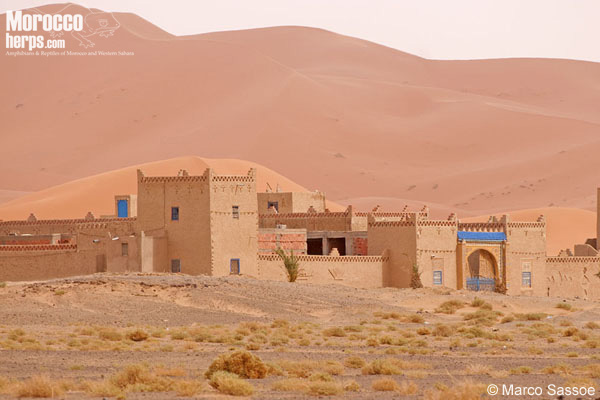
Merzouga landscape. Photo: © Marco Sassoe.

Bufotes boulengeri. Photo: © Marco Sassoe.

Pelophylax saharicus amplexus. Photo: © Marco Sassoe.
The next morning, much refreshed, we took the long drive to Figuig. Halfway, we stopped to prospect the area when suddenly a desert storm appeared once again forcing us into the car. The fourth sandstorm of the trip! Of course things were not going well. We spent two nights at Figuig. The temperature was ideal (25° C), there was no wind, and we had high hopes of finding the North African cat snake (Telescopus tripolitanus) or the saw-scaled viper (Echis pyramidum) that has not been find in that area before. The great walls surrounding the oasis, the abundance of scorpions, spiders, geckos and mammals did foresee the emergence of one of these two rare species, but we didn´t find them. The abundance of water favors the presence of amphibians (we saw many Amietoprhynus mauritanicus and Pelophylax saharicus, and a single Bufotes boulengeri) and rats. August certainly proved to be disastrous in Figuig for reptiles and we could find only Agamas (Agama impalearis), geckos (Tropiocolotes algericus, Stenodactylus petri?, Ptyodactylus oudrii, Tarentola deserti), a sand snake (Psammophis schokari, uniform design) and a viperine snake (Natrix maura).

Oued Ziz landscape. Photo: © Gabri Mtnez.

Boudnib landscape. Photo: © Gabri Mtnez.

Habitat of Stenodactylus petrii? in Figuig landscape. Photo: © Gabri Mtnez.

Strong sandstorm in Figuig. Photo: © Baudilio Rebollo Fernández.
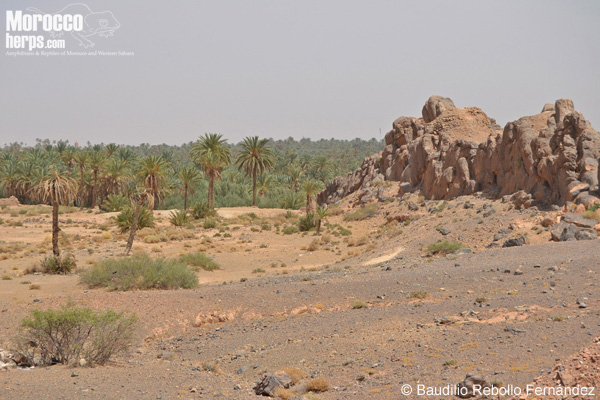
Figuig landscape. Photo: © Baudilio Rebollo Fernández.
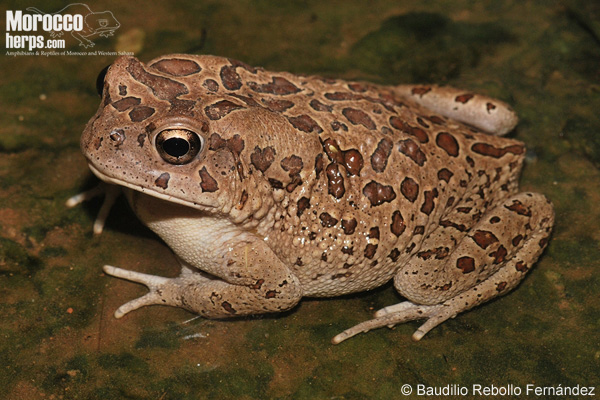
Amietophrynus mauritanicus. Photo: © Baudilio Rebollo Fernández.
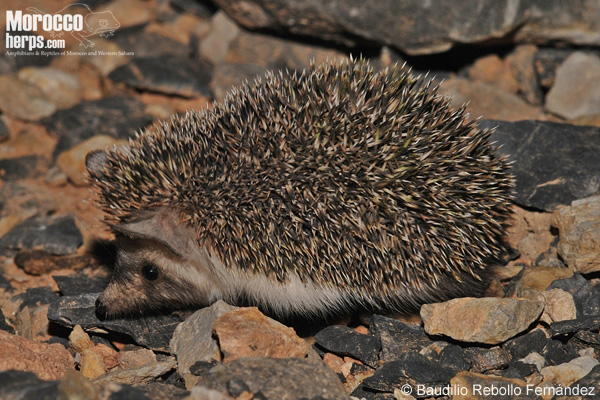
Hedgehog. Photo: © Baudilio Rebollo Fernández.

Pelophylax saharicus. Photo: © Baudilio Rebollo Fernández.
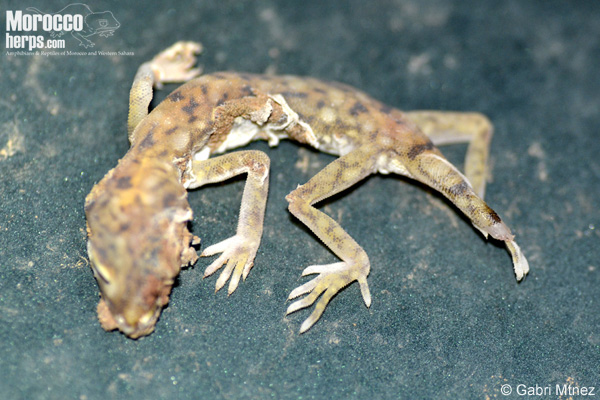
Stenodactylus petrii? dead. Photo: © Gabri Mtnez.

Natrix maura. Photo: © Gabri Mtnez.

Tarentola deserti. Photo: © Gabri Mtnez.

Tarentola deserti, close-up. Photo: © Gabri Mtnez.

Psammophis schokari. Photo: © Baudilio Rebollo Fernández.

Tropicolotes algericus. Photo: © Gabri Mtnez.
We woke up early the next day and began our trip to Ain Bni Mathar. This morning started in a much more positive way. Shortly after leaving the city we observed a sand snake (Psammophis schokari, uniform design) that had just been hit since it was still moving. We then found several active dobs (Uromastyx nigriventris; adults to the side of the road and hatchlings on the road) and a nice false cobra (Rhagerhis moilensis).

Adult Uromastyx nigriventris. Photo: © Marco Sassoe.

Juvenile Uromastyx nigriventris. Photo: © Baudilio Rebollo Fernández.

Rhagerhis moilensis. Photo: © Baudilio Rebollo Fernández.

Rhagerhis moilensis. Photo: © Marco Sassoe.
We drove directly to the north, to the Stipa tenacissima steppe where unfortunately we arrived too late to see Ophisops occidentalis or Psammodromus blanci. Searching in this area we could only observe some snakes sheds (Malpolon insignitus). We then continue to Debdu and we saw a painted frog (Discoglossus sp.) inside a well. We also found a hatchling sand snake (Psammophis schokari, striped design) under a stone and a hooded snake (Macroprotodon cucullatus). At dusk we drove in the habitat of Javenile sand boa (Eryx jaculus), and we observed two Hemorrhois hippocrepis and two Malpolon monspessulanus.

Stipa tenacissima habitat. Photo: © Gabri Mtnez.

Malpolon insignitus, skin. Photo: © Gabri Mtnez.
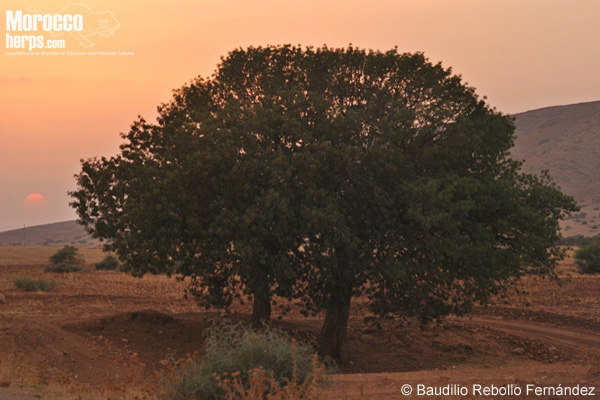
Debdou landscape. Photo: © Baudilio Rebollo Fernández.

Psammophis schokari, stripe design. Photo: © Marco Sassoe.

Macroproton cucullatus. Photo: © Baudilio Rebollo Fernández.
In the next morning we drove to the Middle Atlas. There a neonate Montpellier snake (Malpolon monspessulanus) crossed the road. In addition, we found some lizards (Psammodromus algirus, Podarcis vaucheri) and a juvenile Moroccan Eyed Lizard (Timon tangitanus).

Middle Atlas landscape. Photo: © Gabri Mtnez.

Malpolon monspessulanus, juvenile. Photo: © Baudilio Rebollo Fernández.
We then reached a small mountain village, where we had the pleasure to meet some of the residents. Despite the lack of credibility inherent in the testimony of local people, we always show them photos of Moroccan herps. This time, they quickly identified the viperine snake (Natrix maura, they even showed us a specimen that had been killed some days earlier) and the Lataste viper (Vipera latastei). They did not recognize, however, the Moorish viper (Daboia mauritanica), or the Atlas dwarf viper (Vipera monticola). When we showed them a picture of the horned viper (Cerastes cerastes) many of them said: “Guercif”. The weather was cloudy and we only found some lizards (Podarcis vaucheri). This high mountain habitat seems optimal for Lataste vipers (Vipera latastei).

Middle Atlas landscape. Photo: © Gabri Mtnez.

Podarcis vaucheri, adult. Photo: © Baudilio Rebollo Fernández.

Middle Atlas landscape. Photo: © Marco Sassoe.
It was getting dark when we arrived in the tourist areas of the Middle Atlas (Ifrane-Azrou). We stopped to flip stones and found some wall lizards (Podarcis vaucheri), two skinks (Chalcides lanzai), many eyed lizards (Timon tangitanus) and a subadult Montpellier snake (Malpolon monspessulanus), that was in the shedding process.

Podarcis vaucheri, juvenile. Photo: © Marco Sassoe.

Timon tangitanus, female head close-up. Photo: © Gabri Mtnez.

Adult male Timon tangitanus. Photo: © Gabri Mtnez.

Malpolon monspessulanus. Photo: © Marco Sassoe.

Chalcides lanzai. Photo: © Gabri Mtnez.
The next morning we visited a spectacular Middle Atlas area where we hiked for several hours. We found several individuals of North African green toad (Bufotes boulengeri), a very high density of lizards (many Podarcis vaucheri, some Scelarcis perspicillata, 1 Psammodromus algirus and quite a lot of Timon tangitanus), two viperine snakes (Natrix maura) and a lovely southern smooth snake (Coronella girondica).

Middle Atlas landscape. Photo: © Baudilio Rebollo Fernández.

Scorpion eating a beetle under a stone, close to a dry Podarcis. Photo: © Gabri Mtnez.
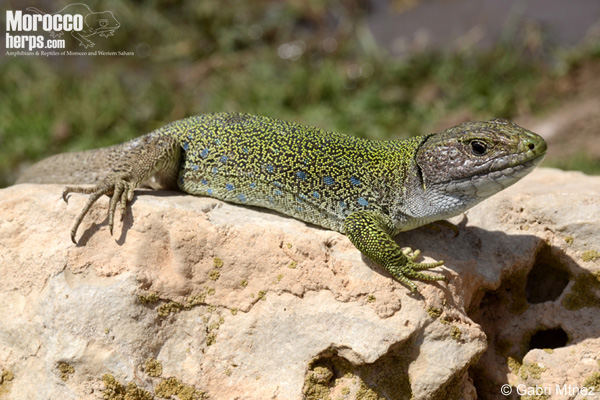
Timon tangitanus. Photo: © Gabri Mtnez.

Timon tangitanus. Photo: © Gabri Mtnez.
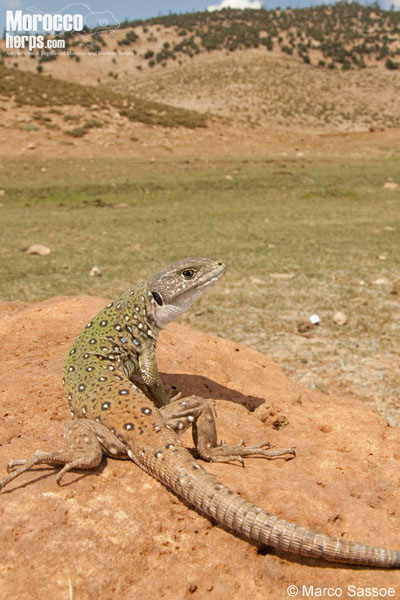
Timon tangitanus. Photo: © Marco Sassoe.

Timon tangitanus. Photo: © Marco Sassoe.

Middle Atlas landscape. Photo: © Marco Sassoe.

Natrix maura. Photo: © Baudilio Rebollo Fernández.

Scelarcis perspcicillata. Photo: © Baudilio Rebollo Fernández.

Coronella girondica. Photo: © Baudilio Rebollo Fernández.

Coronella girondica. Photo: © Baudilio Rebollo Fernández.
At this point we faced the final stretch of the trip and we were exhausted. Despite this we took a long drive South to the High Atlas as we wanted to find at least one specimen of Vipera monticola. The next day, we observed some lizards (Podarcis vaucheri) and a viperine snake (Natrix maura) with a cool reddish coloration close to a mountain lake, where we were astonished by an incredibly-high density of green frogs (Pelophylax saharicus).

High Atlas lagoon. Photo: © Gabri Mtnez.

Pelophylax saharicus. Photo: © Baudilio Rebollo Fernández.

Podarcis vaucheri, basking. Photo: © Gabri Mtnez.
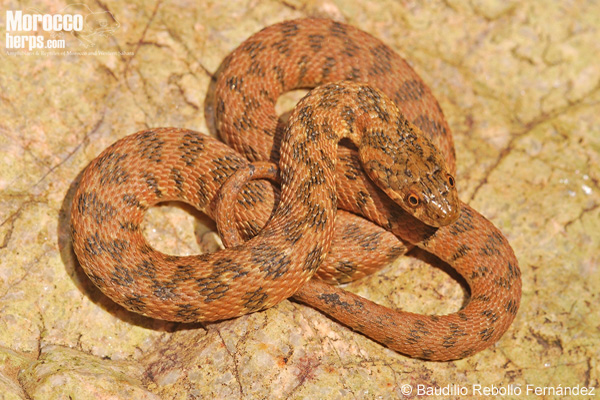
Natrix maura, reddish coloration. Photo: © Baudilio Rebollo Fernández.
We then left the lake and visited a rocky slope. As the temperature began to rise we observed Toubkal lizards (Atlantolacerta andreanskyi) and some diurnal geckos (Quedenfeldtia trachyblepharus). We were then approached by a Berber who, seeing our interest in snakes, told us that he had seen a snake close to his house. We therefore followed him, a bit incredulous, until we reached his rural residence in a small village located on a grassy slope. His house was surrounded by a wall of rocks where we almost immediately found a “relatively large” viper (Vipera monticola), measuring 37 cm. In the meantime many people had gathered to watch what we were doing, still keeping a safe distance from us and the viper. The snake was opaque and appeared to have been beaten with a stick. However, it was healthy and we have no doubt that after his release from the village this specimen survived normally.

High Atlas landscape. Photo: © Gabri Mtnez.

Atlantolacerta andreanskyi, juvenile. Photo: © Gabri Mtnez.

Atlantolacerta andreanskyi, adult. Photo: © Gabri Mtnez.

Vipera monticola, shedding. Photo: © Baudilio Rebollo Fernández.

Pyrrhocorax pyrrhocorax. Photo: © Baudilio Rebollo Fernández.
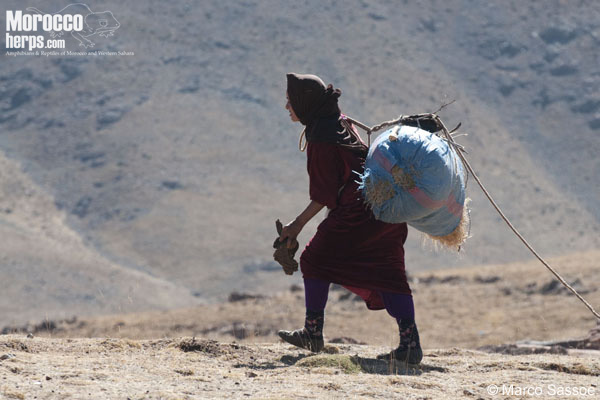
High Atlas woman. Photo: © Marco Sassoe.
Budi and Marco were not completely satisfied and wanted to see a viper that was not opaque, so we continued our search. After two hours of exploration, when the Toubkal lizards (Atlantolacerta andreanskyi) and diurnal geckos (Quedenfeldtia trachyblepharus) were more active, we found another viper (Vipera monticola), with a beautiful colour. We took some pictures before it disappeared in the bush in which it lived.

Quedenfeldtia trachyblepharus. Photo: © Gabri Mtnez.
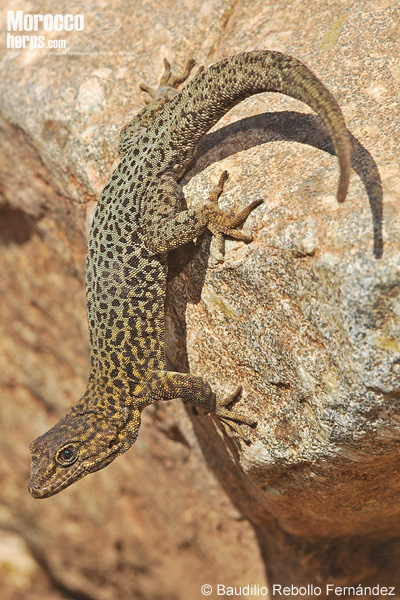
Quedenfeldtia trachyblepharus. Photo: © Baudilio Rebollo Fernández.

Vipera monticola. Photo: © Baudilio Rebollo Fernández.

Vipera monticola. Photo: © Marco Sassoe.

Vipera monticola. Photo: © Marco Sassoe.

High Atlas landscape. Photo: © Baudilio Rebollo Fernández.
At this point we were exhausted, but happy for the many species seen during this Moroccan adventure, and we drove to Marrakech where we could have dinner, take a relaxing cup of coffee with milk in Jemaa el-Fna square and say goodbye to Morocco. Circumstances forced us to travel to this country in August, when weather conditions are extreme and herp activity is very low. Still, we said goodbye with a smile and with a phrase in mind: We will come back to Morocco!!!
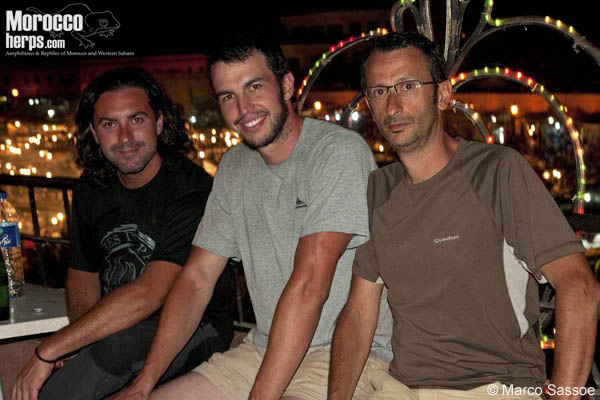
Budi, Gabri and Marco in Jemal L Fna square. Photo: © Marco Sassoe.

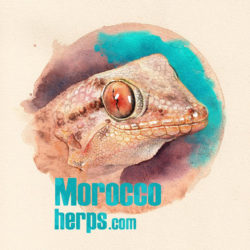
New trip report!
English version:
http://t.co/6Zs12HswGa
Spanish… http://t.co/yZKu5Sat73
Really very nice !!!
Thanks Tomas!
Hi Gabri,
usually fantastic pics like every time!
For me your dead Steno is a petrii – immediately stepped tail after cloaca.
But – are you sure for your first picture of Ch. polylepis and the one of Ch. lanzai? Both look a bit like ocellatus.
Thanks Mario.
Yes, I also think that it is petrii, maybe Cerastes vipera also occurs in Figuig?? 🙂
About Chalcides, the first polylepis I am sure is polylepis, ocellatus has bigger ocells, and also different habitat. In Guelmim, close to the coast I have never found ocellatus.
About lanzai, your are right, it is very very similar to ocellatus! But I was consulting the Atlas and there is no ocellatus there, so it must be lanzai :S
… and yes, its written Sauradactylus brosseti – not brosetti
Thanks Mario, You’re right! Fixed 😉
impresionante Budy!!!
Conratulations! All pics are excellent!
Thanks Bayram. Before this trip I already knew that Budi was a good photographer, but after the trip I have discovered that Marco Sassoe is an excellent photographer too! Maybe we should organize a trip to Turkey! 😉
Amazing pics!! Unos bichos y paisajes increíbles 🙂
Fantastic photos!
Excellent photographic travelogue !!! If any of you ever make it to the Phoenix, Arizona, USA area, I’d love for you to present a talk on your trip to the local herp group – the Arizona Herpetological Association. Please contact me in advance by email — bill@bluechameleon.org .
Dear Bill, Marco Sassoe visited AZ several times. And Budi and me are always talking about a visit to AZ so if finally we visit Phoenix it would be a honour to talk to the AHA about the Moroccan herpetofauna. I keep your email. Cheers and thanks for your comment
Hi Bill, thanks for your comments. Cale Morris is a good friend of mine and I have made several trips to AZ (unfortunately not in the last two years). I hope I can make it again next summer and it would be great to meet you at the AHA. Actually, if Gabri and Budi will also join it would be fantastic to meet all there…and then go herping!
Fantastic diversity and photography.
Hi all, very interesting, lot of knowledge and chace too !! Congrats !!!
Many species… in August! Very hot and dry season for reptiles…
Very good for the informative work with the local people. First, it shows people that many snakes are completely harmless and very beneficial predators of rats and mice, and on the other hand because they realize that the rich herpetofauna of Morocco, well managed, can be a source of income generating specialized tourism.
Congratulations!
Thanks Javier. For me the interaction with local people was one of the most interesting aspects of this trip (and avoiding interactions with people is almost impossible in Morocco!). Usually, Moroccans were very nice, they were curious about what we were doing and they were ready to help (my impression was they were excited by something new that was happening in their ordinary lives). On the other side these people have many superstitions about reptiles. One policeman told us that if one gets bitten by a Uromastyx the only thing to do is to cut his head (of the Uromastyx of course!). Most people we met seemed not to distinguish between venomous and non venomous snakes (though they appeared to know vipers and the cobra) and were scared to death even by harmless snakes. The impression is that they would kill every snake they meet if they have the chance to do so. As you know better than me, Morocco faces many problems (poverty, low education levels…), and it will be very difficult to educate people to live in a sustainable way and gain respect for the territory they live in. This is a major problem also in richer countries, isn’t it? Still, If I go back to Morocco, I will try to talk to people as much as possible and try to convince them that the only good snake is a live one! 🙂
Thank you very much for the wonderful text and photos! I envy you for this trip 😉
Awesome! Excellent pictures.
-Mike
Enhorabuena chicos! a pesar de las condiciones duras propias del mes y de las bajadas y subidas de actividad habéis logrado ver un gran número de especies y de animales fantásticos!. Muy interesante la gran variedad de hábitat visitados y la diversidad encontrada en ellos. Me parece extremadamente curioso y espectacular encontrar una Dasypeltis activa en ese mes, realmente sorprendente.
Una pena los animales encontrados muertos y como os han comentado, yo también me alegro de la interacciones positivas con las personas locales y las serpientes.
Saludossssssssss.
Chapeau…
Excellent report, and beautiful pictures!. Thanks!!!
Wow, congratulations for this amazing trip. Just to highlight a couple of things. Thanks a lot for sharing your knowledge with the local people, it’s wonderful that you convinced them to pet one of the most amazing animals ever, thanks! Regarding your sightings, I’m completely blown away, how did you manage to find and catch another Varanus? How do you do it? How big was it? It looks huge. Finally, thanks for adding in that beautiful chough. Thanks for sharing. All the best. Alfredo.
Look like you had a fantastic time. Cant wait to get out there myself in May….
I was there too last summer. Great photos! Respect! 🙂 Your site is very useful!